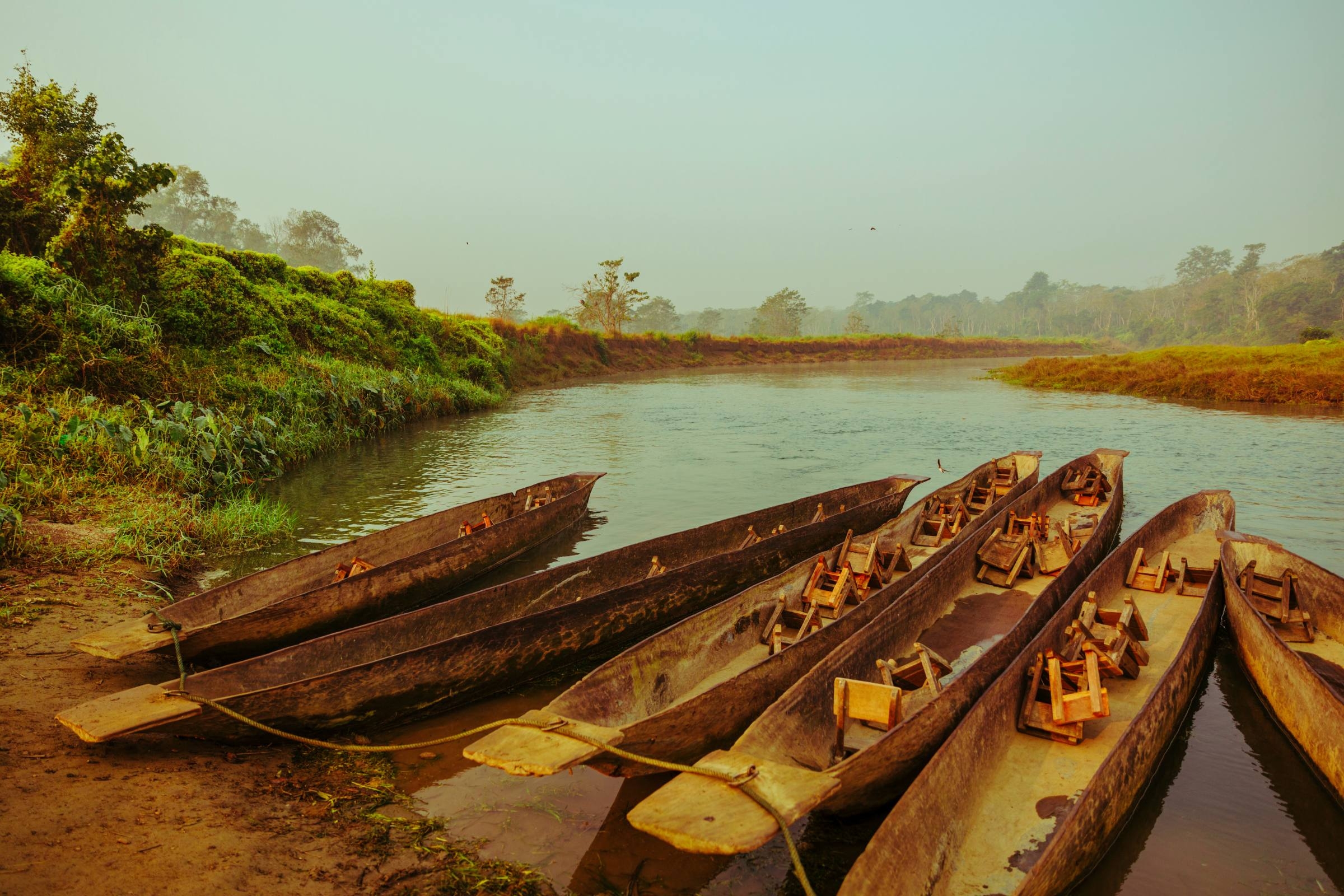
The various representative groups from local communities and also authorities and planners have jointly worked on shaping visioning scenarios for Tomorrow’s Rapti City.

Sharing Group works on Visioning Scenarios for Tomorrow’s Rapti City, Photos: NSET/Tomorrow’s Cities
The Provincial Infrastructure Development Authority (PIDA), Lumbini has collaborated with Tomorrow's Cities, a UKRI GCRF research project to ensure the future Rapti City, the Lumbini Provincial Capital City (LPCC) is built resilient to disasters. The local governments from Rapti & Gadhawa Rural Municipalities and Shitaganga Munipality are the key stakeholders of the collaboration. The aim is to work together to incorporate Tomorrow's Cities Decision Support Environment (TCDSE) into the development of Rapti City. The collaboration is implementing effective strategies and measures that will contribute to the overall resilience and sustainability of the Capital City in the face of potential hazards and challenges. Tomorrow's Cities embodies the essence of disaster risk reduction, forging a path toward future cities in a risk-informed manner.
Shaping Visioning Scenarios for future city is one of the key milestones of the TCDSE process. Visioning Scenarios Validation Workshop has been held in Rapti from September 14-15, 2023. There were 6 stakeholder groups on the same assemblage of disaggregated stakeholder groups - identified in the Future Visioning stage of the TCDSE. The groups were formed of representatives from Tharu, Migrants (Pahade), Squatters, Madhesi-Muslim-Dalit, Ethnic (Magars) and the Planners & Authorities. The groups participated in group discussions & exercises and contributed to shape Visioning Scenarios for their own city.
The workshop was designed in different segments: Discussion on Land Use Plan (LUP) for Future Rapti City, Discussion on Trade Off and Equity Check, Hazard Impact Brainstorming, Impact Priority Exercise and Policy Discussion. In Rapti City of Nepal, the representatives from various groups of local communities and also authorities and planners have jointly worked on shaping visioning scenarios for Tomorrow’s Rapti City. Here follows a brief report covering major outcomes of the Workshop.
Discussion on Land Use Plan (LUP) for Future Rapti City
Participants wer introduced to, first, the interpretations of the land use plans they produced in the previous stage, Future Visioning. The participants were then made able to understand all the land use plans, and confident enough to later challenge the interpretations of planners, and overall suggest changes to the products. The participants in each group agreed that most parts of the Land Use Plan and the infrastructures that were envisioned by themselves in Future Visioning Workshop have been considered in the Land Use Map. However, they have recommended some changes and additions to be made in the Land Use Plan map.
Tharu Group had originally not thought of an airport but later conceived of the plan thinking that there might be a need in the future urbanized city. Now, the Airport area is near to the highly populated area andthere is no sufficient flat space available for an airport within the city. Hence, they suggested to shift the airport to somewhere in Gadhawa or Lamahi within Deukhuri valley. They also wished to connect the ring road. A signature bridge is planned to be built near Basantapur and they would also like to add one bridge after each 2km along the river.
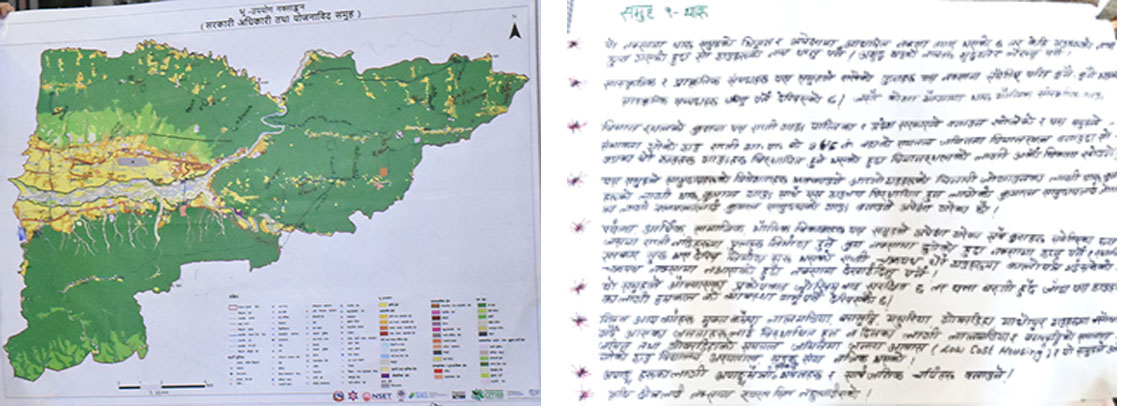
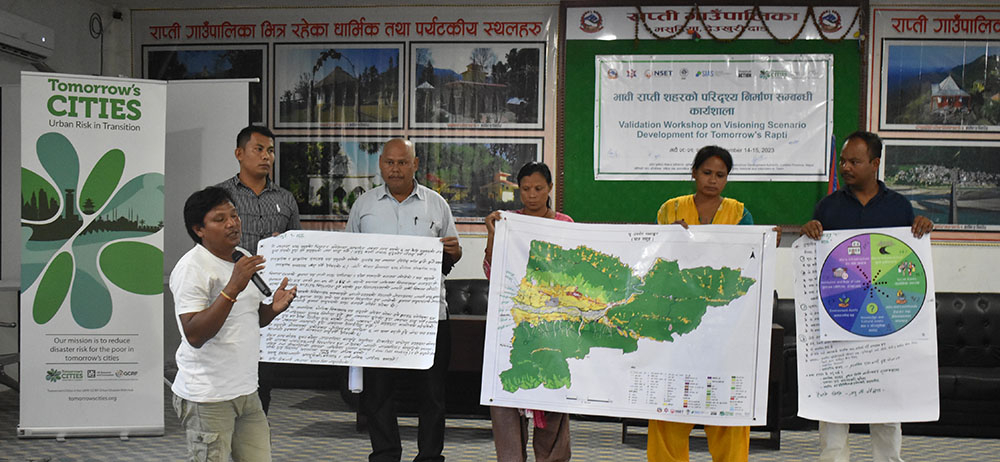
Modifications in Land Use Map by the Tharu Group, Photos: NSET/Tomorrow’s Cities
Other groups also engaged in brainstorming the Land Use Plan for their future city and made efforts to bring them in shape.
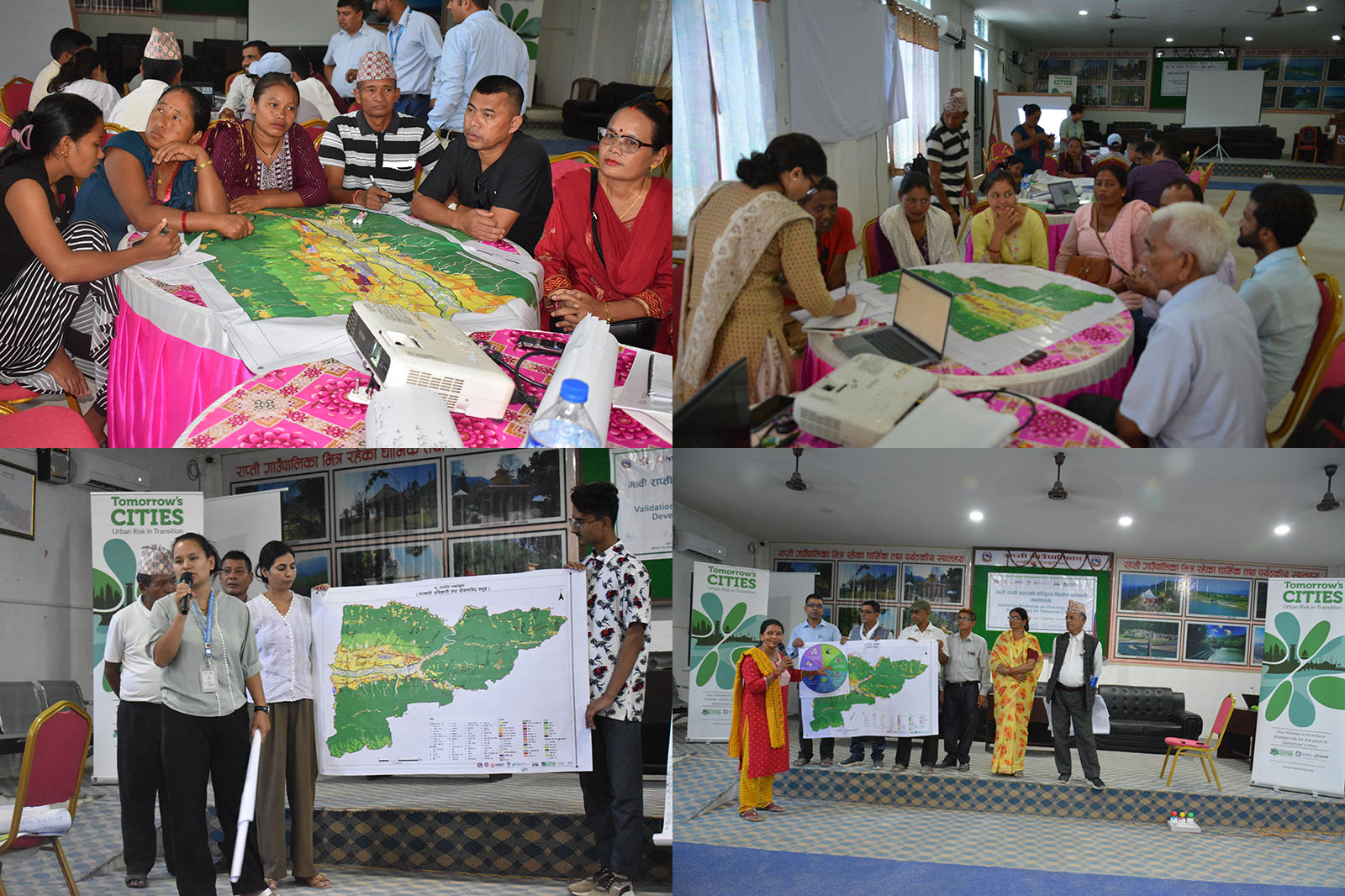
Group Works and sharing on Land Use Plan for Future Rapti, Photos: NSET/Tomorrow’s Cities
Discussion on Trade Off and Equity Check
Each group then discussed on equity concerns focusing on pro-poor philosophy. Who is likely to benefit more from your decisions in this plan? Will your choices serve the urban poor or disadvantaged and marginalized groups in the future? How accessible are low-income households from critical services & other opportunities?
Groups have suggested for High income settlement near East West Highway and Postal Highway, Low-income settlement near the bank of river and Jungle and all other middle-income settlement. Group have also highlighted the need to provision of land ownership certificate to all the squatter dwellers.
Hazard Impact Brainstorming
The participants were advised to name the different things that could happen after a hazard hits their future city which they have envisioned. Discussion on existing hazard was done to note down the major impacts of the existing hazards. This brainstorming was done based on the community hazard mapping which was conducted with the same group prior to the future visioning workshop.
Community Hazard Map by Squatter Group
As shown in the map, the Squatter Group, has identified four main hazards: Flood, Fire, Landslide, and Earthquake. The group prioritized flood, fire, landslide, and earthquake in a sequence of their experience with those hazards. Also, the participants highlighted the three major impacts of these hazards and linked all the impacts with the seven assets of the wheel of urban assets. The major impacts of these existing hazards are identified as follows:
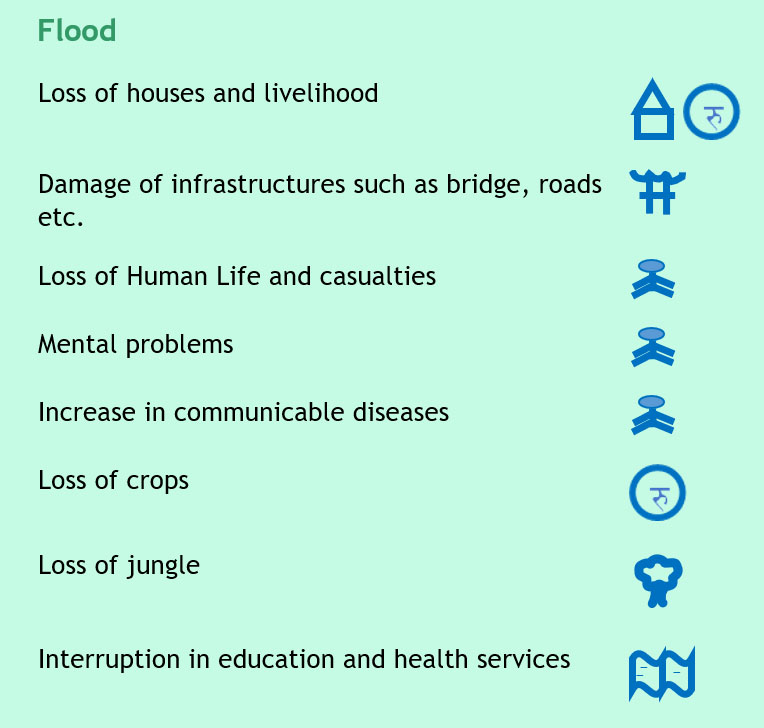
The squatter group has worked for Fire, Landslide and Earthquake too.
Each group has completed this exercise of Hazard Impact Brainstorm.
Legends of the assets of the Wheel of Urban Assets:
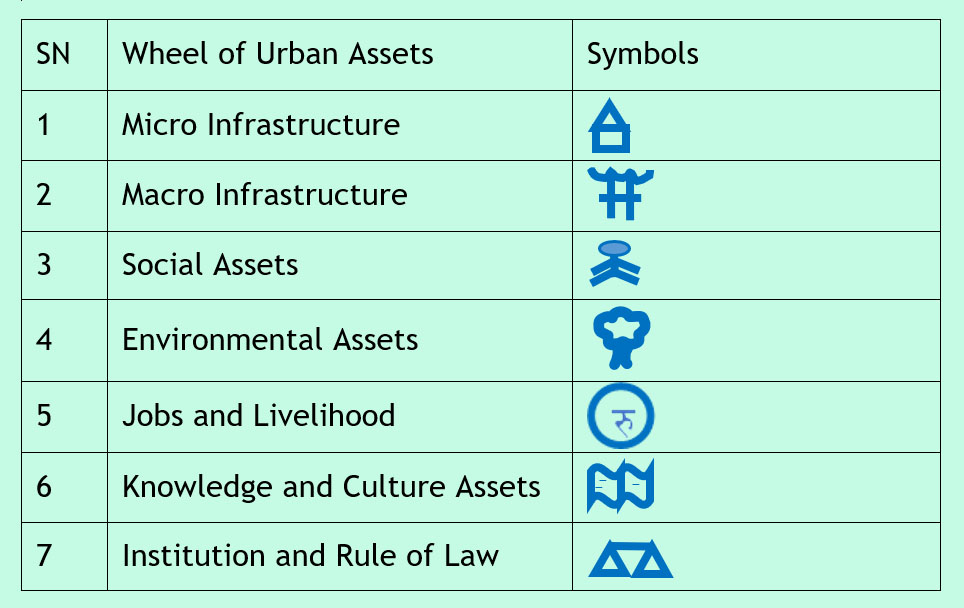
Impact Priority Exercise
In this stage, participants discussed and voted on their collective priorities and justify their choices. Participants had a budget of 25 stickers and they used this budget to define what their priority ‘clusters’ are in the event of a hazard. This step helped connect disaggregated groups collective identities and perceptions that would be used to provide a bespoke definition of risk.
To prioritize the impact, the wheel of urban assets was provided to each individual group. The participants from Squatter Group were allowed to prioritize the impact based on the hazard brainstorming exercise.
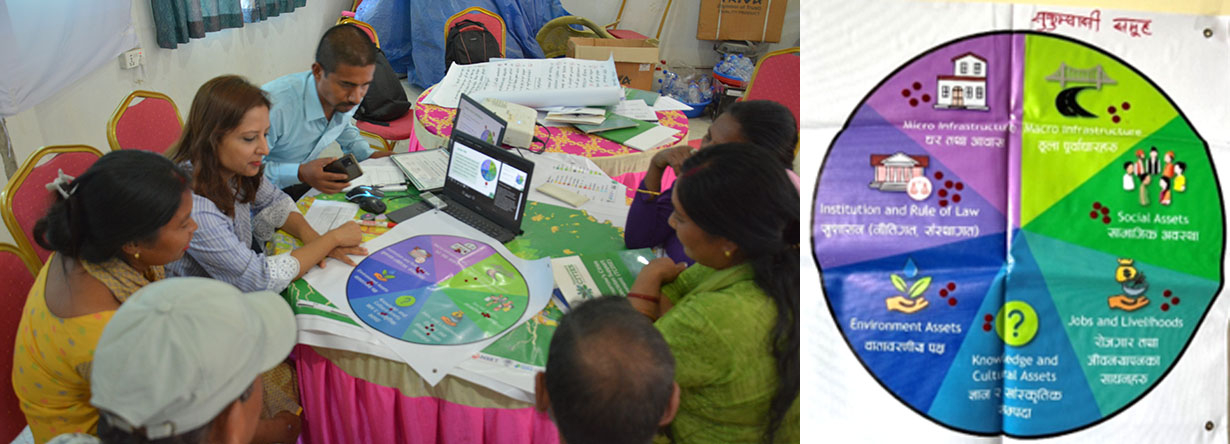
Wheel of Urban Asset and Impact Prioritization by Squatter Group, Photos: NSET/Tomorrow’s Cities
The squatter group prioritized Institution and Rule of Law first (6 points), as they believe if there are policies to govern the plans, then everything will be properly institutionalized and thus function well. They prioritized social assets and micro-infrastructure equally in a second number (4 points) believing that these two assets impact their life directly. After this, they prioritized environmental asset, jobs and livelihood and macro-infrastructure (3 points) believing that all of these have some major indirect impact on life and could not be prioritized less over the other. The least prioritized is the knowledge and cultural assets (2 points) as the group think that if everything else works well then this can be taken care of.
Each group did this exercise to prioritize impact based on their analysis.
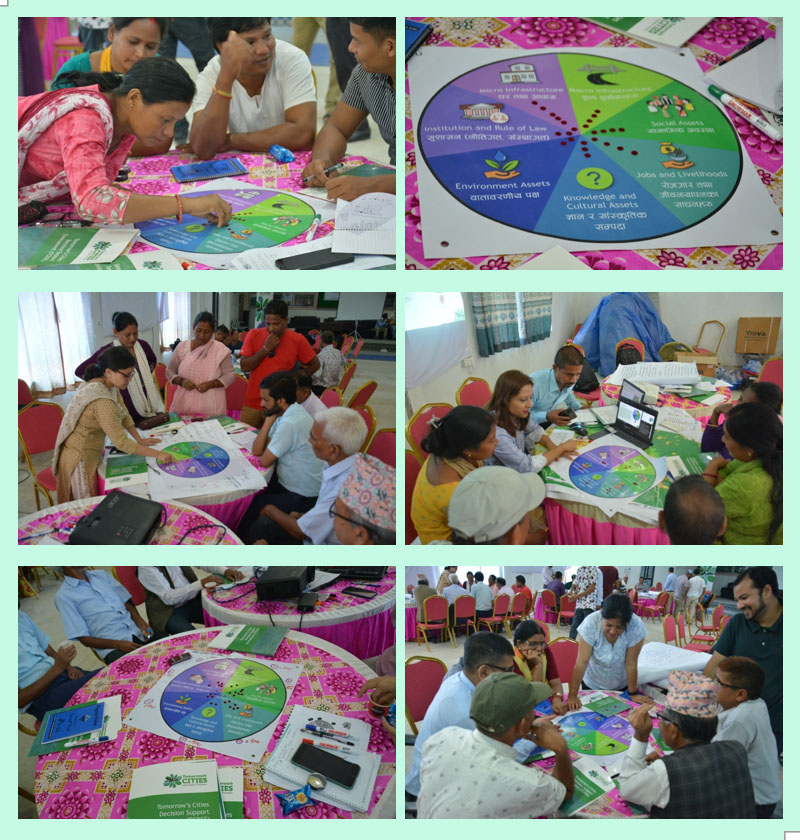
Policy Discussion
Each team recalled the policies that were produced by the groups during previous task. They worked to detail policies, and refine them so they would be more efficient at tackling the impacts of future hazards. Each team then had an opportunity to discuss their policies and refine them. The groups still had the power to choose whether to change or further detail their policies.
The Planners and Authorities Group had identified following policies during the Future Visioning Workshop:
- Disaster Risk Management Policy.
- Policy to conserve natural and cultural heritage.
- Local Land Use Policy.
- Institutions and the rule of law.
- Environment, institutions, and the rule of law.
- Social capital, institutions, and the rule of law.
- Employment and Livelihood policy.
- Environmental Policy.
- Micro-infrastructure, Social Capital and Environment Policy
The participants agreed to these policies and added one new policy: Building and Infrastructure Development Bylaws.
After the discussion the prioritized policies got modified as follows:
- Building and Infrastructure Development Bylaws: This policy can reduce disaster risk directly after making the building and infrastructure safe. National Building Code 2020, The Fundamental Construction Bylaws on Settlement Development, Urban Planning and Building Construction 2015 and local government’s building bylaws can help formulation of this policy.
- Disaster Risk Management Policy: This policy can reduce disaster risk directly by identifying the risk areas. Disaster Risk Reduction and Management Act 2017, Disaster Risk Reduction and Management (DRRM) Rules 2019, and Local Disaster and Climate Resilience Planning Guidelines of Rapti (LDCRP Guidelines) 2017 can help formulation of this policy at local level.
- Local Land Use Policy: This policy can be formulated based on Land Use Act 2019, Land Use Policy 2015, Land pooling reference manual 2017, National Land Policy, 2019 and Land Act, 2021. There are some constraints for implementation of this policy but awareness raising and enhanced citizen engagement help resolve the issues.
At the end of the two days long exercise, each group made presentation and shared their insights and opinions.
Opening Session of the Validation Workshop

Opening of Validation Workshop jointly done by Mayor of Shitaganga, Chairperson from Rapti & Vice Chairperson from Gadhawa and Dr. Max Hope from Tomorrow’s Cities resaerch project, Photo: NSET/Tomorrow’s Cities
To begin with, the speakers from the Local Governments and project highlighted the importance of this process in due course of preparing for better future city.
For detail Click Here